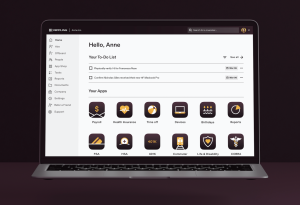Everyone Will Need a Cloud Like Amazon, says Citrix
![]() When it comes to cloud services and VMware partners in particular, there’s always a hint of competition amongst its supporters, even in the most cooperative sense of the word. But this coop-atition is also what helps drive innovation across an entire industry, and during a panel discussion on theCube at VMworld this week, three executives share their vision of the cloud’s future, and what the most disruptive aspect of the cloud is going to be (full video below).
When it comes to cloud services and VMware partners in particular, there’s always a hint of competition amongst its supporters, even in the most cooperative sense of the word. But this coop-atition is also what helps drive innovation across an entire industry, and during a panel discussion on theCube at VMworld this week, three executives share their vision of the cloud’s future, and what the most disruptive aspect of the cloud is going to be (full video below).
Krishna Subramanian, VP of Marketing for VDI in a Box at Citrix, starts out talking about the balance her company must strike when leveraging products from VMware, as they have a shared vision for end user computing. As we’ve noted, Citrix is very much dedicated to this concept of BYOD–Bring Your Own Device. They’ve been a leader in the mobile anythime, anywhere any device trend. Enabling smartphones, tablets and laptops to run Windows applications, Subramanian recognizes that the line between the desktop and apps is blurred. “People just want access, and that’s what we’re here to enable,” she says.
There’s certainly a high level of interest for cloud services at the top of the stack, where end user computing is concerned. But what’s going on deeper in the enterprise, where cloud adoption is still an iffy case? “It’s going to take some time for enterprises in particular to move to the cloud in a public fashion, and we’ll have different kinds of clouds tailored for this,” says Sameer Dholakia, Manager of Cloud Platforms Group at Citrix. “We’ll see more tier 1 and tier 2 applications move to the cloud, and see more enterprises building on premise.”
That’s when panel moderator John Furrier steps in, asking if the cloud momentum is really happening. He notes another trend we’ve picked up on at SiliconAngle, regarding fast movement in the commercialization of open source cloud, but can these emerging platforms handle the demand?
“There’s a slew of companies building infrastructure, randing from enterprise to SMBs,” Dholakia goes on. “What we’ve seen at Citrix via our acquisition of Cloud.com is interest is broad. Large server providers recognize they need to build a cloud like Amazon. Next gen enterprise services like Zynga have their own scaled out cloud running behind their technology.”
Watch live video from SiliconANGLE.com on Justin.tv
While Citrix is looking to aid its customers in building their own powerful, large scale clouds, Nirvanix is addressing cloud flexibility for its clients. “We’re in triple digit growth and our clients are putting real data in the cloud,” says Scott Generaux, CEO of Nirvanix. “We have something we call the hybrid cloud. Customers don’t want isolated islands of cloud. when we put something on a customer’s floor they also have access to our public cloud. They can move that data around, in the event of a natural disaster. They can download that image anywhere in the world and be up and running. You need both. It’s not public by itself, and private doesn’t give the same flexibility of the federation of the hybrid.”
![]() With so many companies looking to have their own cloud, or leverage open cloud solutions for rapid development, Furrier wonders if there’s a real product behind initiatives like OpenStack, which have a great deal of movement behind them, but is it growing fast enough to meet demand for real products?
With so many companies looking to have their own cloud, or leverage open cloud solutions for rapid development, Furrier wonders if there’s a real product behind initiatives like OpenStack, which have a great deal of movement behind them, but is it growing fast enough to meet demand for real products?
“One of the reasons we acquired Cloud.com is speed to market, Dholakia says. “They have 65 product clouds built on their platform, including Zynga. That product is there. We believe in OpenStack and in the open source community, and we have dozens of engineers to help accelerate that.”
Generaux on the other hand, emphasizes OpenStack’s immaturity on the storage side. “Few [customers] are using it for storage and it seems to be more mature for server offerings. There’s a lot of issues around it–things like auto-sync aren’t built in. I go back to my storage background–what makes Netapp a great company is they have software integration built in. Today we’re integrated with Netapp and others, and it’s taken us years to do this.”
As the panel wraps, Furrier asks each member what they feel the most disruptive technology will be in the next year. For Subramanian, it’s about economics, saying “the value of cloud is democratizing it and making it available to anyone at a good price.” Dholakia notes the need for enterprise organizations to build large scale clouds like Amazon and Rackspace, noting Citrix’s position in helping them build such a fundamentally different architecture in the cloud. And for Generaux, it’s all about data accessibility and reselling. “You’ll see application providers who never sold storage before with a cloud interface, and they’ll have to start selling storage,” he says. “The power of the cloud is in how you move the data around, and how people use the data internally, but also externally.”
A message from John Furrier, co-founder of SiliconANGLE:
Your vote of support is important to us and it helps us keep the content FREE.
One click below supports our mission to provide free, deep, and relevant content.
Join our community on YouTube
Join the community that includes more than 15,000 #CubeAlumni experts, including Amazon.com CEO Andy Jassy, Dell Technologies founder and CEO Michael Dell, Intel CEO Pat Gelsinger, and many more luminaries and experts.
THANK YOU













